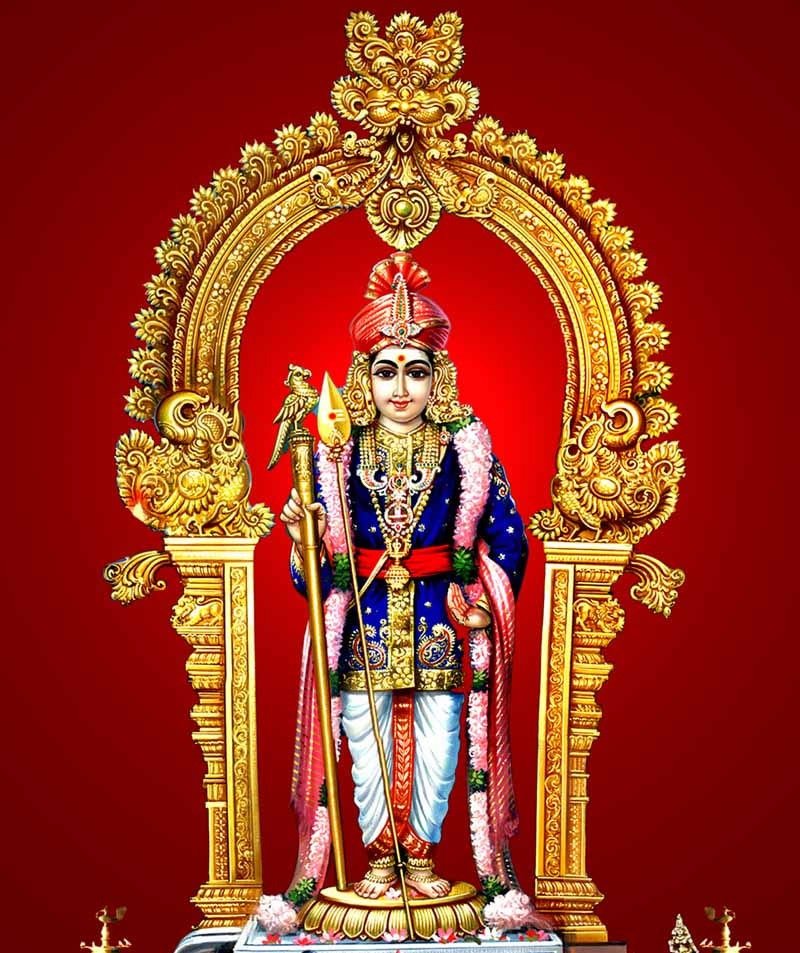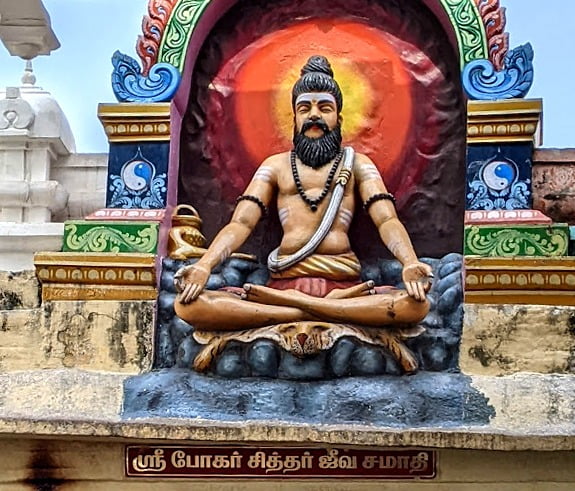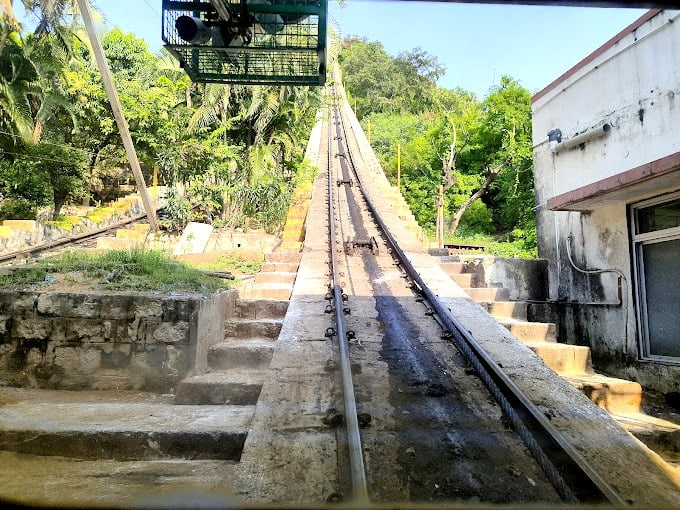Dhandayuthapani Swamy Temple, Palani
Dhandayuthapani Swamy Temple, also known as Palani Temple or Arulmigu Dhandayuthapani Swamy Temple, is a renowned Hindu temple located in Palani, a town in the Dindigul district of Tamil Nadu, India. It is one of the Six Abodes of Murugan (Arupadai veedu) and holds great religious significance for devotees of Lord Murugan.

The temple is situated on Palani Hill, which is part of the Western Ghats. Devotees have to climb a long flight of steps or make use of a winch facility to reach the temple, which is perched on top of the hill. The arduous climb is considered an act of devotion and penance.
The presiding deity of the temple is Lord Murugan, depicted as Dhandayuthapani, which means “one who holds the staff.” The idol of Lord Murugan is made of Navapashanam, a sacred combination of nine herbs. It is believed to have been created by the renowned sage Bogar.
The temple also houses shrines dedicated to various other deities, including Lord Ganesha, Goddess Valli (the divine consort of Lord Murugan), and Goddess Deivanai (another consort of Lord Murugan).
Dhandayuthapani Swamy Temple is famous for its vibrant festivals and rituals. The Thai Poosam and Panguni Uthiram festivals are celebrated with great fervor. During Thai Poosam, devotees undertake a pilgrimage to the temple, carrying kavadis (ornate structures) as offerings to Lord Murugan. The Panguni Uthiram festival marks the celestial wedding of Lord Murugan and Goddess Deivanai and attracts a large number of devotees.
Palani Temple is not only a religious center but also a place of natural beauty. The panoramic views from the hilltop are breathtaking, with the town and surrounding landscapes spread out below. The temple premises also include the Thiru Avinankudi Temple, where devotees begin their climb to the main temple.
Visiting the Dhandayuthapani Swamy Temple offers devotees a spiritual experience amidst serene surroundings. It continues to be an important pilgrimage site for devotees seeking the blessings of Lord Murugan.
Contents
- 1 History:
- 2 Architecture:
- 3 Temple Speciality:
- 4 Dhandayuthapani Swamy Temple Timing:
- 5 Places to visit near Dhandayuthapaniswamy Temple:
- 6 You may also like to check other temples:
- 7 FAQ:
- 7.1 Q: Where is Palani Temple located?
- 7.2 Q: When was Palani Temple built?
- 7.3 Q: What is the significance of Palani Temple?
- 7.4 Q: What are the main deities worshipped at Palani Temple?
- 7.5 Q: What are the festivals celebrated at Palani Temple?
- 7.6 Q: What are the timings of Palani Temple?
- 7.7 Q: What is the dress code for visiting Palani Temple?
- 7.8 Q: Are there any special rules or regulations for visiting Palani Temple?
- 7.9 Q: Where can I stay near Palani Temple?
- 7.10 Q: Where can I eat near Palani Temple?
- 7.11 Q: How can I get to Palani Temple?
- 8 Additional FAQ:
- 9 How to reach the temple:
- 10 Google Maps:
History:
The history of Dhandayuthapaniswamy Temple, also known as Pazhani Temple, dates back several centuries. The temple has a rich and fascinating history associated with the worship of Lord Murugan. While the exact origins of the temple are not well-documented, it is believed to have been a sacred site for worship even before the temple was built.
According to popular legend, the temple is associated with a sage named Bhogar, who was an ardent devotee of Lord Murugan. It is said that Bhogar created the idol of Lord Murugan out of Navapashanam, a composite of nine medicinal herbs with special spiritual significance. This Navapashanam idol is the main deity in the temple and is believed to possess great divine power.
The construction of Dhandayuthapani Swamy Temple as it stands today is attributed to the Nayak rulers of Madurai. They are believed to have built the main shrine and developed the temple complex during their reign in the 16th century. Over time, the temple has undergone renovations and expansions under the patronage of various rulers and devotees.
The temple has also witnessed several significant events in its history. One notable event is the visit of the famous Tamil poet-saint Arunagirinathar, who composed the Tiruppugazh hymns, praising Lord Murugan. It is believed that Arunagirinathar’s visit to the temple and his devotion to Lord Murugan played a crucial role in popularizing the temple and its worship.
The temple has remained a center of pilgrimage and devotion for centuries, attracting devotees from far and wide. The Thaipusam festival celebrated in the Tamil month of Thai (January/February), holds immense significance at the Dhandayuthapaniswamy Temple. The festival involves devotees undertaking a physical and spiritual journey to the temple, carrying kavadis and observing rigorous rituals as acts of devotion and penance.

Architecture:
Gopurams: Dhandayuthapani Swamy Temple is adorned with several towering gopurams (gateway towers) that are intricately carved with sculptures depicting various deities and mythological scenes. These gopurams serve as the main entrances to the temple complex and are a prominent feature of South Indian temple architecture.
Sanctum Sanctorum: The main shrine, where the idol of Lord Dandayuthapani (Murugan) is housed, is located at the highest point of the temple complex. It is designed as a vimana (tower) structure, typically found in Dravidian temples. The vimana is adorned with detailed carvings and sculptures.
Mandapas: The temple complex comprises several mandapas (halls) used for religious ceremonies, gatherings, and processions. These mandapas are supported by intricately carved pillars, depicting various deities and mythical creatures. The pillars often showcase exquisite craftsmanship.
Inner Courtyards: The temple complex features multiple inner courtyards, each serving different purposes. These courtyards provide open spaces for devotees to gather, perform rituals, and participate in religious activities.
Sculptures and Carvings: Dhandayuthapani Swamy Temple is renowned for its beautiful stone carvings and sculptures. The walls, pillars, and ceilings of the temple are adorned with intricate carvings depicting various gods, goddesses, celestial beings, and mythological stories. These carvings are a testament to the artistic skill and craftsmanship of the artisans of that era.
Water Bodies: The temple complex includes several sacred water bodies, such as tanks and wells, which hold religious significance. These water bodies serve as places for devotees to take ritual baths and perform ablutions before entering the temple.
Prakarams: The temple has multiple prakarams (circumambulatory paths) that encircle the main shrine. Devotees walk around these paths as part of their worship and circumambulation rituals.

Temple Speciality:
Navapashanam Idol: The presiding deity of the temple, Lord Dhandayuthapani (Lord Murugan), is depicted in the form of an idol made from Navapashanam. Navapashanam is a sacred amalgamation of nine medicinal herbs with extraordinary healing properties. It is believed that the combination of these herbs gives the idol special spiritual energy and divine power.
Abhishekam with Sandal Paste: One of the distinctive rituals performed at the temple is the abhishekam (ritual bath) of Lord Murugan’s idol using sandalwood paste. This abhishekam is considered highly auspicious and is believed to bestow blessings, peace, and prosperity upon the devotees.
Steps and Winch Facility: To reach the main shrine of Lord Murugan, devotees have to climb a flight of 659 steps on the hill of Solaimalai. The climb is considered a form of penance and devotion. However, for the convenience of elderly and physically challenged devotees, a winch facility is available to reach the Dhandayuthapani Swamy Temple without climbing the steps.
Thaipusam Festival: The Thaipusam festival celebrated at the Pazhani Temple is one of the major annual events. Devotees from far and wide gather to participate in this grand festival. They undertake a pilgrimage to the temple, carrying kavadis (ornate structures) on their shoulders as offerings to Lord Murugan. The festival is known for its fervent devotion, piercing rituals, and vibrant processions.
Traditional Architecture: The temple showcases exquisite South Indian Dravidian architecture. The gopurams (towering entrance gateways) are adorned with intricate carvings depicting various mythological scenes and deities. The main sanctum and other shrines within the temple complex also feature beautiful sculptures and artwork.
Holy Steps: Apart from the steps leading to the main shrine, there is a separate set of steps known as “Pachai Malai,” meaning “Green Hill.” These steps are considered sacred, and devotees climb them to seek blessings and fulfill their vows.
Siddha Bhogar Shrine: Within the temple complex, there is a shrine dedicated to Siddha Bhogar, an ancient Siddha yogi and alchemist. It is believed that he played a significant role in creating the Navapashanam idol of Lord Murugan.
Dhandayuthapani Swamy Temple Timing:
Morning:
Temple opens at 5:30 AM
Afternoon:
Uchikala Pooja: 12:00 PM
Temple closes at 1:00 PM
Evening:
Temple reopens at 4:00 PM
Sayaraksha Pooja: 6:00 PM
Rakkalam: 8:00 PM
Temple closes at 8:30 PM

Places to visit near Dhandayuthapaniswamy Temple:
Palani Hills: The Palani Hills are part of the Western Ghats and offer breathtaking natural beauty. You can explore the hills, enjoy scenic views, and even go on trekking trails.
Kuthiraiyar Dam: Located around 15 kilometers, Kuthiraiyar Dam is a picturesque reservoir surrounded by lush greenery. It’s a great spot for picnics and nature walks.
Varathamanathi Dam: Situated about 18 kilometers, Varathamanathi Dam is another beautiful reservoir. The dam offers panoramic views and is a peaceful spot to relax.
Shanmuga River: The Shanmuga River flows near the Murugan Temple. It is considered sacred, and taking a dip in its waters is believed to be purifying.
Thiru Avinankudi Temple: This temple is located at the foothills of Palani and is dedicated to Lord Shiva. It is believed to be one of the holy places mentioned in the hymns of the Nayanmars.
Ayyanar Sunai: Ayyanar Sunai is a small village located about 18 kilometers. It is known for its natural springs and is a serene place to visit.
Mariamman Kovil: Dhandayuthapani Swamy Temple is dedicated to Goddess Mariamman, a manifestation of Goddess Durga. It is located near the Palani bus stand and is visited by devotees seeking blessings.
Palar Dam: Palar Dam is situated around 50 kilometers. It is a popular spot for boating and offers scenic views of the surrounding landscape.
Shenbaga Devi Amman Temple: Located in nearby Udumalaipettai, this temple is dedicated to Goddess Shenbaga Devi. It is known for its unique architectural style and spiritual significance.
You may also like to check other temples:
Kanipakam Varasiddhi Vinayaka Swamy,
Tirumala Tirupati Venkateswara Swamy,
Twelve Sacred Jyotirlingas of Lord Shiva and
Shakti Peethas: The Power of Shakti.

FAQ:
Q: Where is Palani Temple located?
A: Palani Temple is located in the town of Palani, Dindigul district, Tamil Nadu, India. It is about 110 kilometers from Madurai and 100 kilometers from Coimbatore.
Q: When was Palani Temple built?
A: Palani Temple is believed to have been built in the 6th century AD by the Pallava king, Mahendravarman I. It was later renovated by the Chola, Pandya, and Vijayanagara kings.
Q: What is the significance of Palani Temple?
A: Palani Temple is one of the six most sacred Abodes of Murugan, also known as Arumugam or Subramanya. It is also one of the Pancha Bootha Sthalams, or five elemental temples of Murugan, representing the element of air.
Q: What are the main deities worshipped at Palani Temple?
A: The main deity worshipped at Palani Temple is Murugan, also known as Arumugam or Subramanya. He is worshipped in the form of a Swayambumurthi, or self-manifested idol. The temple also houses shrines to various other deities, including Valli, Deivanai, Vinayaka, and Ganesha.
Q: What are the festivals celebrated at Palani Temple?
A: The main festivals celebrated at Palani Temple are the Thai Poosam festival in January-February, the Panguni Uthiram festival in March-April, and the Skanda Shashti festival in October-November.
Q: What are the timings of Palani Temple?
A: Palani Temple is open from 6:00 AM to 12:00 PM and from 4:00 PM to 8:00 PM.
Q: What is the dress code for visiting Palani Temple?
A: Devotees are advised to wear decent clothing when visiting Palani Temple. Men are advised to wear dhotis or kurtas, and women are advised to wear sarees or salwar kameez.
Q: Are there any special rules or regulations for visiting Palani Temple?
A: Devotees are not allowed to wear footwear inside the temple. They are also not allowed to take photographs or videos inside the temple.
Q: Where can I stay near Palani Temple?
A: There are a number of hotels and guesthouses located near Palani Temple. Devotees can also stay at the temple’s own guest house.
Q: Where can I eat near Palani Temple?
A: There are a number of restaurants located near Palani Temple serving both vegetarian and non-vegetarian food. Devotees can also eat at the temple’s own canteen.
Q: How can I get to Palani Temple?
A: Palani Temple is well-connected by road, rail, and air. Devotees can take a taxi or bus from Madurai or Coimbatore. They can also fly to Madurai Airport or Coimbatore Airport and take a taxi or bus to the temple.
Additional FAQ:
Q: What is the significance of the Kavadi pilgrimage to Palani Temple?
A: The Kavadi pilgrimage is a religious ritual performed by devotees of Murugan. The devotee carries a Kavadi, which is a wooden or metal structure decorated with flowers, peacock feathers, and other religious symbols. The Kavadi can weigh anywhere from a few kilograms to several hundred kilograms. The devotee carries the Kavadi from their home to Palani Temple, a journey that can take several days or even weeks. The Kavadi pilgrimage is a way for devotees to show their devotion to Murugan and to seek his blessings.
Q: What are the different types of Kavadi?
A: There are many different types of Kavadi, each with its own significance. Some of the most common types of Kavadi include:
- Milk Kavadi: The devotee carries two pots of milk on their shoulders. This type of Kavadi is performed to seek Murugan’s blessings for good health and prosperity.
- Peacock Feather Kavadi: The devotee carries a Kavadi decorated with peacock feathers. This type of Kavadi is performed to seek Murugan’s blessings for success in one’s endeavors.
- Vel Kavadi: The devotee carries a Kavadi decorated with a Vel, or spear, which is Murugan’s weapon. This type of Kavadi is performed to seek Murugan’s protection from evil.
Q: What are the safety precautions that devotees should take when carrying a Kavadi?
A: Carrying a Kavadi can be a physically demanding
How to reach the temple:
By Air:
The nearest airport to Palani is Coimbatore International Airport, located approximately 108 kilometers away. From the airport, you can hire a taxi or take a bus.
By Train:
Dhandayuthapani Swamy Temple has its own railway station, Palani Railway Station, which is well-connected to major cities in Tamil Nadu and other parts of the country. You can check for trains that pass through Palani and plan your journey accordingly.
By Road:
Temple is well-connected by road and can be easily accessed by buses, taxis, or private vehicles. Here are a few options:
From Coimbatore: Palani is approximately 108 kilometers from Coimbatore. You can take a bus or hire a taxi from Coimbatore. The journey takes around 2-3 hours, depending on the traffic.
From Chennai: Temple is located about 470 kilometers from Chennai. You can take a direct bus from Chennai to Palani, which takes around 8-9 hours. Alternatively, you can also take a train from Chennai to Palani.
From Madurai: Palani is around 115 kilometers from Madurai. You can take a bus or hire a taxi from Madurai. The journey takes approximately 2-3 hours.
Local Transport:
Once you reach Palani, you can easily find local transportation options such as taxis, auto-rickshaws, and cycle rickshaws to reach the Dhandayuthapani Swamy Temple. The temple is located on a hill, and there is a winch facility available for those who prefer not to climb the steps.
